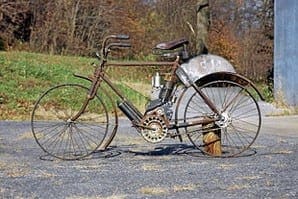
In the last part I sorted out all the bits and pieces required to rebuild Angie’s faithful Honda CB125TDC which had arrived at my garage amid clouds of oil smoke and badly needing a rebore. Now with all the new gaskets and parts assembled on the bench and shiny new pistons ready to be fitted it’s time to roll up my sleeves and start putting it all back together.
Full captiond below, for step-by-step images and captions, visit the image gallery.
Picture one: With the crankshaft assembly fitted into the left crankcase half, the next job is to install the gearbox shafts and selector mechanism. It should be a fairly straightforward job to engage the shafts into their respective bearings, though a little patience may be necessary to make sure the selector forks themselves are correctly engaged in their grooves.
Picture two: Now the right crankcase half can be offered into place. Unusually, the little Honda engine uses a gasket between the crankcase halves. A smear of grease will hold it in place during assembly. Make sure the gear shafts and crankshaft engage into their respective bearings, then gently tap the crankcase home with a rubber mallet.
At this stage I always refit a couple of crankcase half screws and carefully check that everything rotates as it should before bolting it up tight. If in any doubt separate the cases again and persevere until everything is located correctly.
If the cases won’t meet up correctly, stop and investigate the reason, don’t be tempted to use force.
Picture three: When satisfied that all the internals were present and correct I refitted the starter motor to the front of the engine. This simply bolts in place. Remembering the long and tortuous route taken by the starter motor lead, I chose to refit it to the starter motor terminal before proceeding further. The lead tucks in between the starter motor housing and crankcase and would be difficult to thread into place later.
Picture four: Next in place is the adapter plate for the starter motor, which has a new gasket fitted on either side. I then hooked the starter motor chain around the starter clutch and the starter drive sprocket and carefully slid the sprocket onto the starter whilst simultaneously engaging the generator rotor on to the crank end. With everything in place the crank centre bolt can be tightened.
Pic five: Moving to the other side of the engine, the gearchange shaft can now be slid through the crankcases and engaged with the end of the gear selector drum. The star-shaped boss on the end of the drum engages with the spring-loaded detent arm, which can also be refitted at this stage.
The detent roller clicks into the recesses in the star as the selector drum rotates and provides the positive ‘click’ you feel when changing gear.
The photo shows the gears in neutral. Temporarily re-fit the gear lever at this stage and make sure all the gears are selecting properly before proceeding further.
Picture six: Now the clutch assembly can be refitted along with the primary drive gear on the crank end. Make sure any spacers or washers behind the clutch are replaced in the same order they were removed, then lock the engine in place and refit and tighten the clutch centre nut and the crank nut.
Honda like to lock these in place with dished ‘Belville’ washers under the nuts; make sure they’re correctly fitted. They will be marked ‘outside’ on their outer face.
Picture seven: Re-fit the clutch springs and pressure plate and clutch lifter pushrod. The oil pump assembly mounts onto the crankcase with three countersunk screws. I chose to rebuild the oil pump earlier and re-fit it as an assembly, which means the mounting screws have to be fitted and tightened through slots in the pump body and drive gear.
Give them a tap with an impact driver to make sure they’re tight. Make sure the crank oil feed plunger is in place in the crank end and engaged correctly with its drive pin, then fit the clutch case. Again, I used a new gasket smeared with grease.
Picture eight: Now I turned my attention to the engine’s top end. The first job was to fit the new pistons supplied with the re-bore. With the rings already in place I started by fitting the inner gudgeon pin circlip to each piston, then offering the pistons up to the small ends one at a time and sliding the gudgeon pins into place. Generously lubricate the small ends with fresh engine oil first.
Picture nine: Now the two outer gudgeon pin circlips can be popped in place. This can be a tricky job with parts this small – I always hook one end of the circlip in place before easing the other end of the circlip over into the groove with a small screwdriver. A small recess machined in the piston will help but be careful the new circlip doesn’t spring out and disappear across the garage or, even worse, down into the crankcase! To make sure the circlips are properly engaged I always try rotating each one in its groove by pushing the end around with a screwdriver.
Picture 10: Probably the most delicate part of the whole rebuild is engaging the piston rings into the bores. The little Superdream has a 180 degree crank throw which means one piston is at the top of its stroke while the other is at the bottom, so you can engage one piston at a time instead of both together as on 360 degree twins. This makes life a little easier but some care is still needed to engage the rings squarely.
I lubricated everything generously with fresh engine oil before gently easing each ring into its groove with a small screwdriver as I lowered the barrel into place. Don’t forget the new base gasket first and check that any dowels and O-rings are present and correct. Check the engine turns over smoothly before proceeding.
Picture 11: With the barrels in place, the front camchain slipper blade can be fitted. In order to stop the camchain dropping irretrievably into the engine I also looped a piece of wire around it. Again, check any dowels are present and fit new O-rings around them. Oil for the camshaft feed travels up these studs and leaving out the O-rings will lead to oil leaks.
With a new head gasket in place the head can be lowered over the studs and bolted up finger tight with the two long bolts at the rear of the camchain tunnel and the shorter one at the front.
Picture 12: The camchain tensioner stud should now engage into the barrel. Press the tensioner blade right back against the inside of the camchain tunnel and lock it up with the locknut. This holds the tensioner in the ‘fully off’ position and gives much more room for the next step of fitting the camshaft. Don’t forget the small bolt which clamps the top of the tensioner to the cylinder head.
Picture 13: To re-fit the camshaft, first offer the cam sprocket onto the camshaft and then hook the camchain over the camshaft. The sprocket has an egg-shaped cutaway in the centre so it will drop low enough on the camshaft to let you feed the camchain into place. One of the cam bearings also simply slides off, giving a little more room to manoeuvre everything into place.
Finally lift the cam sprocket up onto its mounting boss on the camshaft. Note the tiny dowels on the cam bearings which engage with the oil feed cutaways on the cylinder head face.
Picture 14: The valve timing must be absolutely correct or the engine will not run. Honda have thoughtfully provided timing marks on the edge of the generator rotor which you can see here. With the generator cover temporarily replaced, remove the small inspection cap and gently rotate the engine until the TL mark lines up to the pointer. This places the left hand piston at top dead centre.
Picture 15: Now position the camshaft so both lobes are facing downwards on the left hand cylinder. Line up the cam sprocket with its mounting holes on the camshaft and look for this punchmark which should be in line with the cylinder head face. If it isn’t, hook the camchain around the sprocket until everything lines up. Then re-fit the two cam sprocket bolts with a smear of Loctite and tension up the camchain. Double check the timing marks for correct alignment before proceeding.
Picture 16: Now lubricate the cam lobes with fresh engine oil and offer the two rocker carriers into place. Again, watch for dowels but there are no O-rings to worry about here. The carriers aren’t left and right handed but are best replaced in their original positions.
Next the head nuts can be replaced and torqued down. If you don’t have a tightening sequence work diagonally outwards from the inner studs to avoid any chance of distorting the cylinder head. Finally tighten down the three retaining bolts which were left finger tight at step 11.
Picture 17: Set the valve clearances at this stage. The handbook will give correct settings but I set the Hondas clearances at four and six thou for the initial start-up. They’ll need to be checked and re-set once the engine has run for a couple of hundred miles. Note the two studs which have been fitted to retain the cam cover – an acceptable bodge if the budget is tight but don’t forget to check for adequate clearance underneath for the cam lobes.
Picture 18: While I’ve been busy assembling Angie’s engine, someone has been busy polishing up the little bike’s twin carburettors.
The one on the right has been washed off with paraffin and a toothbrush before receiving the Solvol Autosol treatment. This is also a good time to check the carb float heights and clean out the jets.
Picture 19: Re-fitting the engine is fairly easy on these bikes. I offered the engine into place and slid the upper rear bolt home before lifting the engine at the front and sliding in the other bolts. A smear of Copper Grease on the engine bolts will prevent them seizing up in future.
The carbs push onto stubs on the head and clamp in place with clips. Watch for any sign of splitting on the inlet stubs as air leaks here will affect the carburation.
The CB125T also has a rather weedy looking stainless steel link arm between the carbs which links the choke butterflies. Make sure it’s engaged properly or the choke cable will only work on one carb.
Picture 20: Re-fitting the hoses from carb to air cleaner can be troublesome as they invariably harden with age and exposure to petrol fumes.
Usually a quick dip in very hot water is enough to soften them up for fitting.
The little Honda, unusually, has two separate air filter boxes and I found it easiest to fit the carbs and hoses first then offer the air filter boxes into place. Incidentally, David Silvers advised me that the hoses for this bike are no longer available.
Picture 21: A quick glance inside the generator cover confirmed all is as it should be before re-fitting. The generator stator coils provide power to keep the battery charged and the lights working. The small magnetic sensor offset to the right is the ignition sender, which sends a magnetic pulse to fire the ignition coils each time the trigger on the rotor passes it.
Make sure all the wiring is routed correctly and the insulation is in good condition when re-fitting.
A faulty neutral light on this bike was traced to a wire which had been trapped by a carelessly replaced sprocket cover.
Picture 22: The ignition coil and rectifier unit mount on opposite sides of the main frame member over the engine. Two studs pass through two rubber mountings to keep the components safe from vibration. I found one of the studs had a stripped thread and I had to grind it off and fit a replacement before re-fitting. The wiring harness and tacho cable are all held in place by metal loops. Make sure everything is clipped in place properly.
Picture 23: The fuel tank slides into place on its two rubber bobbins. A spray of WD40 onto the rubbers will help it engage properly before bolting it down with the single bolt at the rear.
Don’t forget to re-fit the fuel pipe before turning the tap on!
Picture 24: The clutch cable hooks into its operating lever at the lower end before…
Picture 25: …engaging it into the handlebar lever and setting the clutch adjustment. There should always be a little slack in the cable to make sure the clutch lifter isn’t under load.
Picture 26: Finished and running. The little Honda engine not only runs better, it also looks much tidier than it did. In addition to respraying the major engine parts with VHT black I also stripped the cam cover back to bare metal with Nitromors and wire wool before recoating it with Finningans Smoothrite to duplicate the original finish.












